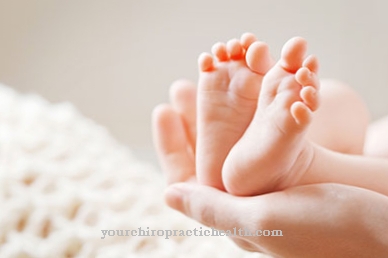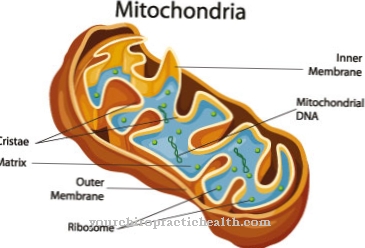The Ichthyosis (ichthyosis) is one of the skin diseases that is noticeable by increased flaking. There are different forms of this disease, which differ from each other.
What is Ichthyosis?
.jpg)
© matoommi - stock.adobe.com
Behind the name Ichthyosis (ichthyosis) hides a hereditary skin disease, which is associated with a strong, diffuse cornification disorder. This often affects the entire skin. Occasionally the disorder will too Fish scale disease called.
It exists in different forms. In exceptional cases, ichthyosis is part of a syndrome. Regardless of the form of the disease, this disease is not contagious. What kind of ichthyosis a person suffers from is defined by the type of inheritance. Apart from that, the different forms show different signs and different types of tissue appearances on the skin.
Furthermore, transitional forms occasionally occur. The symptoms of the disease usually exist since birth. Sometimes, however, they only develop in the first few years of life. The different forms include ichthyosis vulgaris and congenital ichthyosis.
causes
For almost all types of Ichthyosis a defective carrier of the genetic makeup is the cause. Since defects in the genes are generally inheritable, this skin disease is also a hereditary disease. The genetic error leads to a disruption in the layers of the skin. There is no normal skin formation and exfoliation process.
Normally, the skin is constantly renewing itself. The epidermis is made up of several layers. In its lowest layer, new cells are formed, which merge into the layers above. On the way there, the cells keratinize and die. Due to the cell migration, the horny layer can renew itself approximately every four weeks.
If the skin is intact, there is a healthy balance between the formation of new cells and peeling. In ichthyosis (ichthyosis), on the other hand, the natural exfoliation is impaired, so that visibly large flakes of skin develop.
Symptoms, ailments & signs
Depending on the type and severity, ichthyosis can cause very different symptoms, complaints and signs. A large, plate-like cornification of the skin is typical for fish scale disease. These skin changes, which are mostly scaly, can exist from birth or develop in the first weeks and months after birth.
Ichthyosis vulgaris usually breaks out three to twelve months after birth. This shape can be recognized by the gray to greenish skin changes that appear on the extensor sides of the arms and legs. Occasionally, the fine flakes of skin also appear on the scalp. The affected skin is dry and soft and peels off when touched. The skin color can be brownish to yellowish, occasionally there is bleeding under the cornification, which discolors the skin in the affected area reddish.
The ichthyosis hands and feet are also typical of ichthyosis vulgaris. The skin lines take on a rough shape, which makes the skin appear wrinkled in some places. Symptoms of neurodermatitis also appear in a quarter of patients. The risk of asthma is also increased. If the ichthyosis is treated early, the symptoms can be relieved quickly. If not treated, serious respiratory infections and other complications can develop.
Diagnosis & course
Diagnosing a Ichthyosis is possible after recording the symptoms and a detailed analysis of the appearance. The type of scaling, the characteristic infestation pattern and the accompanying symptoms indicate the respective form of ichthyosis.
Depending on the suspected form of the disease, further specific diagnostic methods are then used. This is how the doctor analyzes the smallest tissue samples. Furthermore, a potential enzyme deficiency can be detected in the samples or a damaged genetic carrier can be confirmed by DNA analysis.
The course of this skin disease is always protracted. How difficult it is depends on the form of the disease. In very severe forms, a sick infant can die shortly after birth. With mild and moderate forms of ichthyosis, specific complications usually arise in advancing age, which are based on the dry and rigid skin of the person affected.
Complications
Ichtyosis causes severe discomfort and symptoms on the patient's skin. The symptoms appear in childhood, however, so that the diagnosis and treatment of ichthyosis can take place at an early stage. Lumps and scales usually form on the skin. Both men and women are equally affected by the disease.
The skin is constantly losing scales, which has a negative effect on the patient's aesthetics. It is not uncommon for this to lead to a reduction in self-esteem and inferiority complexes. It is not uncommon for the symptoms of ichthyosis to subside in adulthood, so that there are no further complications or complaints.
It is not possible to treat ichthyosis causally. The person concerned can use various creams and ointments to relieve the discomfort. In most cases, baths with various salts also help to reduce the symptoms of ichthyosis. Life expectancy is not reduced by this disease. Should there be psychological complaints, these can be treated by a psychologist.
When should you go to the doctor?
If typical symptoms such as keratinization of the skin or signs of neurodermatitis are noticed, a doctor should always be consulted. Ichthyosis can be treated well if it is detected early. People who notice the first warning signs should therefore consult a doctor quickly. This is especially true if there are risk factors such as neurodermatitis or other skin diseases. Infants who show symptoms of ichthyosis shortly after birth must be treated immediately in a specialist clinic. In less severe cases, the family doctor should be called in.
The medical professional can diagnose the disease and refer the patient to a dermatologist if necessary. A therapist can also be called in if emotional complaints arise as a result of the external changes. The main focus, however, is on treating the physical symptoms. During the therapy, the skin must be examined regularly and, if necessary, an adjustment of the medication is necessary. Therefore, permanent medical supervision is indicated even with minor complaints.
Doctors & therapists in your area
Treatment & Therapy
The therapy one Ichthyosis aims to relieve symptoms. The skin should become more supple through care measures and skin tears should be avoided or treated. Although this cannot be cured, the patient's quality of life can be increased.
Local treatment with specific ointments is an important part of therapy. Furthermore, in most forms of ichthyosis, the skin should be bathed, rubbed and greased twice a day. Urea-containing creams are suitable for this. If the skin is severely affected but not inflamed, derivatives of vitamin A acid can also be used. However, these preparations have some strong side effects, so they should only be taken under strict consultation and control with a doctor.
Apart from local therapy, psychological support for the patient often proves to be useful. Many sufferers feel socially excluded from ichthyosis (ichthyosis), so that these fears can be overcome with the help of therapy or a self-help group.
Outlook & forecast
Ichthyosis is not curable because it is a group of hereditary diseases. However, with good treatment, the symptoms can be greatly reduced. It should be noted that the skin requires lifelong intensive care. The prognosis of ichthyosis is generally good, despite the incurability of the disease with appropriate treatment.
However, since it is not a uniform disease, in rare cases it can also develop into a severe form. In so-called harlequin ichthyosis, for example, patients often die shortly before or after birth from infections or respiratory diseases. Even with the lighter forms of the disease, without therapy and skin care measures, complications can arise that result from dry and inelastic skin. This can cause painful tears in the skin. Sometimes sweating is also made difficult by the constant formation of calluses. In extreme cases, especially at high summer temperatures or physical exertion, this can lead to circulatory collapse due to overheating of the body (hyperthermia).
In some cases, neurodermatitis or asthma also occurs together with ichthyosis. Another consequence of the disease is often the psychological stress on the patient. This can lead to social exclusion and the development of fears, which often makes psychological support necessary.
prevention
Since the Ichthyosis almost always a hereditary disease, there are no special preventive measures. If this skin disease exists, it can be slowed down by certain measures. The natural means of sun and salt water have proven to be beneficial for the sick skin. Furthermore, those affected should not come into contact with skin-damaging or degreasing substances. These can have a negative effect on the course of ichthyosis.
Aftercare
Follow-up care for ichthyosis usually relates to alleviating the symptoms. The exact measures depend on the individual form of the disease. The focus is on intensive care of the affected skin. Contact with salt water and the sun has been shown to have beneficial effects on the clinical picture, which is why doctors often recommend their patients to stay at the sea.
However, increased sweat production is rather counterproductive. Those affected should also stay away from skin-damaging substances. Degreasing substances can also have negative consequences. As the skin dries out due to illness, it needs sufficient water and fat. Patients can choose from special gels and lotions for this.
The doctor knows which products from specialist retailers are particularly effective here. During a consultation in the doctor's office, those affected also find out what an individual treatment with urea, salicylic acid or other active ingredients can look like. Bath oils, soft brushes and sponges are available to free the skin from cornified skin and flakes.
The hard areas can be softened in a steam bath. The attending physician will make suitable recommendations and can also provide information on changing your diet and avoiding stress. If the job is responsible for the illness, those affected should consider changing.
You can do that yourself
Ichthyosis must always be treated depending on the individual symptoms. Since the skin is dried out, it needs water and fat, ideally in the form of special shower gels and lotions from specialist shops. In consultation with the doctor, ichthyosis can also be treated with salicylic acid, urea, lactic acid or vitamin A acid. Scaling the skin works best with table salt and bath oil. Steam baths soften the calluses and allow them to be gently removed with a sponge or soft brush.
The advice of the doctor always applies to internal treatment. As a rule, the doctor will prescribe acitretin tablets, the effect of which is supported by a change in diet and the avoidance of stress.
In addition to these measures, data subjects should also take preventive measures. For example, it usually makes sense to change jobs, because sensitive skin needs a suitable environment in order not to fall ill again. Furthermore, sweat production must be reduced, especially in the summer months. Cool drinks and a first aid kit should always be close at hand. However, should heat stroke or febrile seizure occur, it is best to call the emergency services immediately.


.jpg)

.jpg)

.jpg)

















.jpg)



